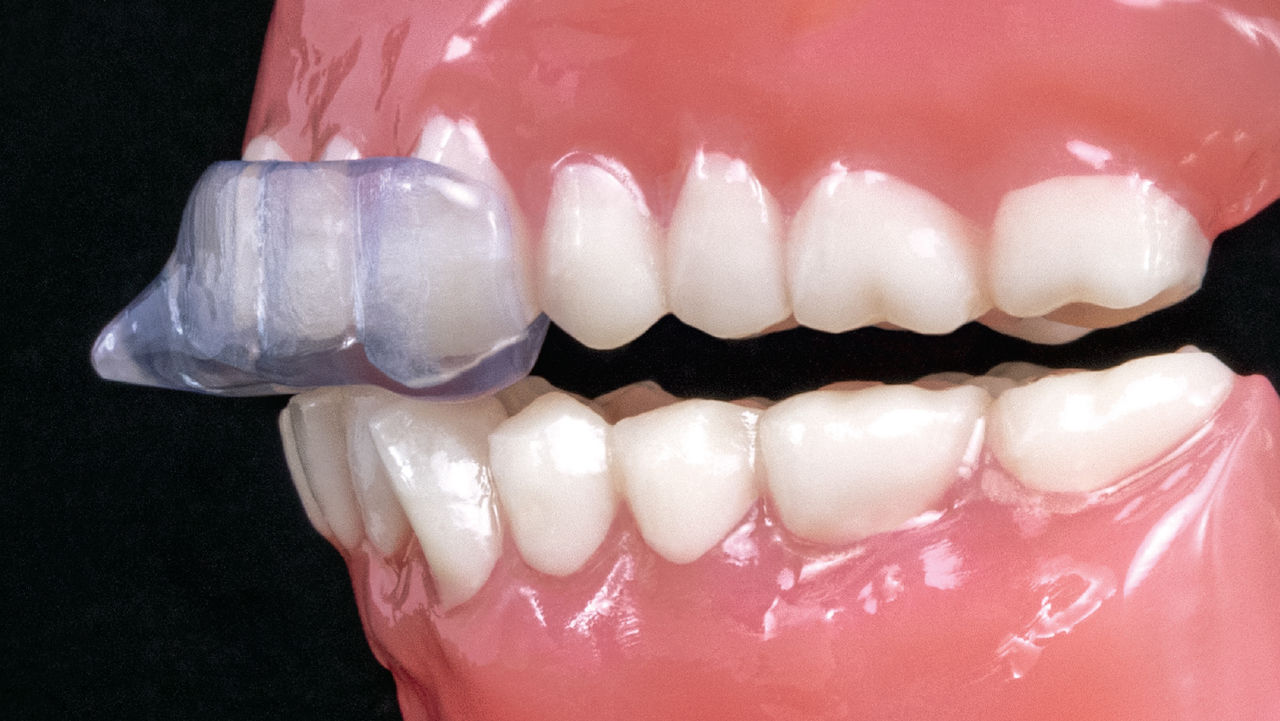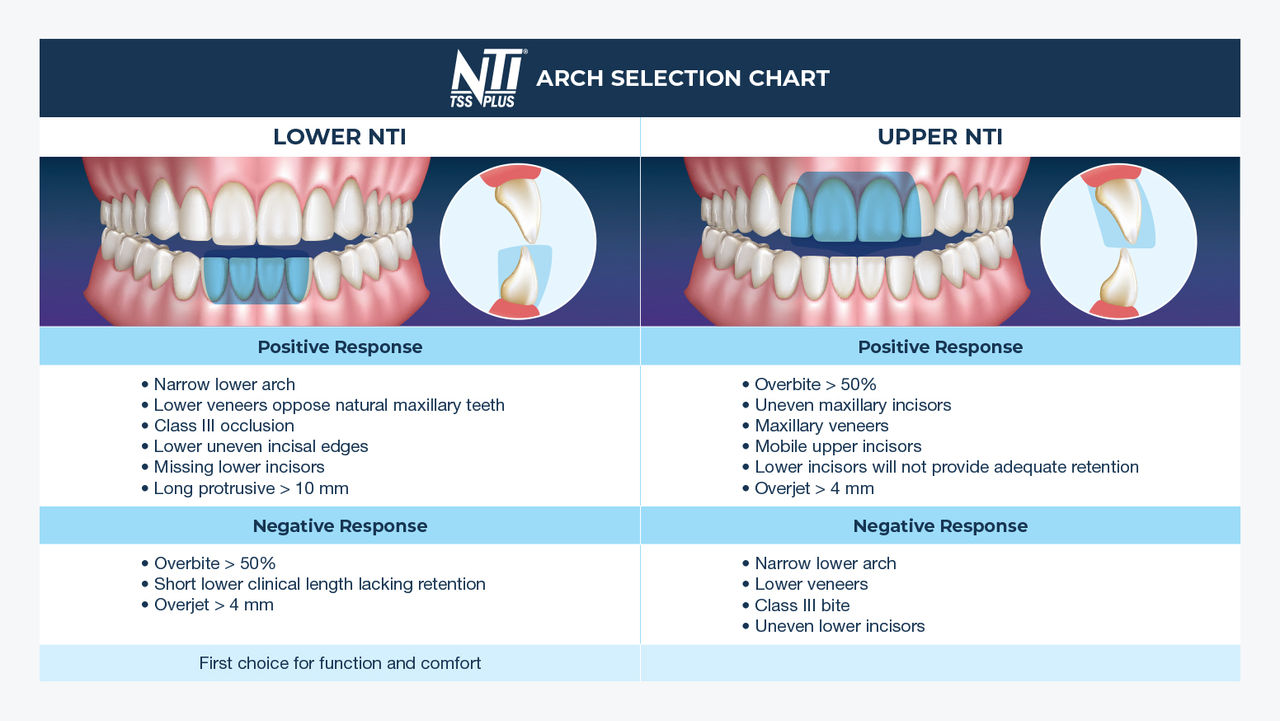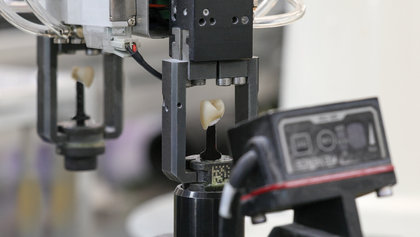Blog Posts
- Dr. Stacy Ochoa: “What I Learned from a Decade of NTI Treatments”
- Randy Clare, Glidewell: “Myths, Migraines and the NTI-tss Plus®”
Magazine Article
800-854-7256 USA
Arch selection for the NTI-tss Plus is critical for a great outcome.

Having prescribed the NTI-tss Plus® in my practice for over a decade, I now use the anterior discluding device as my go-to splint for treating patients who suffer from migraines caused by teeth clenching. The first several NTI devices I delivered provided incredible results for my patients. It felt like I had stumbled upon a miracle cure. One case, however, revealed to me that I still had a lot to learn about the NTI-tss Plus arch selection process.
Jennifer was a 34-year-old female patient with class I occlusion; worn upper incisors, indicating bruxism; and crowding of the lower anteriors, which resulted in an uneven lower incisal plane. Initially, I made her an upper bite splint to protect her dentition and restorations against the harmful effects of bruxism, but at her next hygiene check, she confessed to not wearing it. Jennifer said it was too big and bulky. I reminded her about the importance of wearing the bite splint and recommended that she put it in 30 minutes before bed to get used to it.
At the patient’s next hygiene check six months later, my hygienist asked if anything had changed since her last appointment. Jennifer explained that she had been having two or three headaches each month, which she simply attributed to stress at her job. My hygienist introduced the NTI-tss Plus to her and suggested that it might help with the headaches and protect her teeth, since she was not wearing the bite splint I prescribed. In the office, we had started calling the NTI a “win-win solution” because it protects dentition and dental restorations as well as reduces headaches, migraines, and orofacial pain.
Jennifer initially declined the NTI treatment despite it being presented as a win-win solution, saying that she did not want to invest in yet another appliance that would likely be too uncomfortable to wear. My hygienist understood the patient’s concern and showed her a sample of the NTI-tss Plus, highlighting the appliance’s small size that only extends to the canines.
To reinforce my hygienist’s product description, I myself explained to Jennifer how and why the NTI works. Jennifer joked that she had never seen me so passionate about a particular treatment plan before, and she agreed to go through with it after all. We reviewed the informed consent form, took upper and lower impressions along with a maximum protrusive measurement, and sent the case off to the lab for a maxillary NTI-tss Plus appliance. My rationale for prescribing an upper device was that I wanted to avoid fitting a device over her crowned lower anteriors.
A couple of weeks after being fitted with her first NTI device, Jennifer was back in my chair. Normally, NTI follow-up appointments are positive experiences, with patients raving about its success — often describing how they no longer have jaw pain or migraines, or how fabulous they feel overall. Jennifer’s experience, however, was different.
When I asked how she was feeling with the NTI treatment plan, she admitted that she couldn’t get past the second night of wearing it due to the pain of her lower teeth. I was shocked.
I asked myself a series of questions in response to this unexpected reaction: Why would the lowers hurt when the appliance was made for the uppers? Was there any canine contact? Was she protruding beyond the discluding element?
I did some research and discovered a helpful chart that clearly outlined the indications for upper vs. lower NTI appliances.

Jennifer had lower crowding — an indication for a lower NTI, not an upper NTI like I had prescribed. An upper NTI would not evenly contact the opposing midline, and may encounter resistance in lateral excursions.
I told Jennifer that we were going to make another NTI for her, but on the lower arch this time. We instructed her to wear her full-arch bite splint in the interim. She rolled her eyes at that suggestion, but said she looked forward to trying the lower NTI when it was back from the lab.
When she returned a week later for the fitting of the lower NTI, I thanked her for giving the NTI one more chance. I seated the NTI-tss Plus over the rotated, crowded teeth #22–27, and it fit perfectly. Then, we proceeded with the standard NTI seating checklist, making sure that:
Everything met the standard checklist, but I told her not to hesitate to call us with any issues at all. She agreed, but we did not hear from her for some time.
It wasn’t until a month later that I saw Jennifer’s name back on the schedule. I walked into the operatory, and Jennifer looked like the weight of the world had been lifted off her shoulders.
She recounted how she had been consistently wearing the NTI-tss Plus every night. It was comfortable, and she had no headaches — not a single one since she started wearing it. She told us she felt better in the morning and no longer suffered from anxiety about struggling with headaches during the day.
This kind of positive transformation was what I had been used to seeing after prescribing the NTI-tss Plus. Ever since that case, I have made a point of consulting the NTI arch selection chart to ensure that my patients receive the best fit for their specific bite plane.
Blog Posts
Magazine Article
Send blog-related questions and suggestions to hello@glidewell.com.


